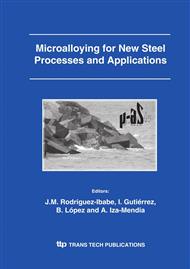p.737
p.745
p.753
p.761
p.771
p.779
p.787
p.795
p.803
Grain Refinement by Rapid Transformation Annealing of Cold Rolled Low Carbon Steels
Abstract:
A novel thermal treatment, rapid transformation annealing (RTA), has been applied to six different cold rolled low-carbon (LC) steel sheets with the aim of refining their microstructure. The process involves rapid heating to just above the austenite (g) to ferrite (a) transformation temperature and subsequent rapid cooling to room temperature. Grain sizes around 2 µm in two different Nb-Ti HSLA steels, 5 µm in a Ti-LC steel and 6 µm in a plain LC (0.037%C) steel have been produced using fast cooling rates (200°C/s). Non-equiaxed structures are obtained in a Nb-Ti HSIF steel and in a plain LC (0.135%C) (CM) steel due to their higher Mn content. However, very fine equiaxed grains (2 µm) are obtained by rapid intercritical annealing (RIA) in the CM steel. Irrespective of the microalloying concept, the grain growth of recrystallized a grains before their transformation was inhibited in CM and in both HSLA steels. This inhibition is connected with the overlapping of a recrystallization and a-g transformation processes which is essential in order to achieve extreme grain refinement either by RTA or RIA.
Info:
Periodical:
Pages:
771-778
Citation:
Online since:
November 2005
Price:
Сopyright:
© 2005 Trans Tech Publications Ltd. All Rights Reserved
Share:
Citation:


